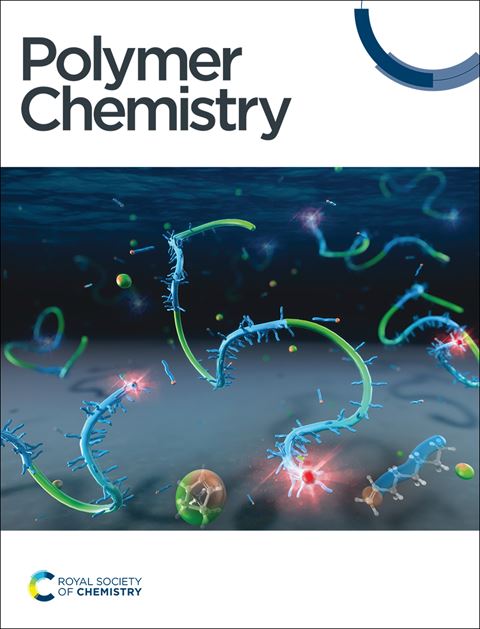Stoichiometric effects on bulk stress relaxation to enhance reprocessability in covalent adaptable networks†
IF 4.1
2区 化学
Q2 POLYMER SCIENCE
引用次数: 0
Abstract
Achieving maximum crosslinking density is often thought to be crucial for high performance and mechanical strength in conventional thermoset covalent adaptable networks (CANs), although some network defects can enhance properties such as toughness and reprocessability. Controlling functional group stoichiometry and crosslinking density is therefore key to better understanding and programming the properties and reprocessability of CANs. Despite efforts to systematically control CAN properties, many previous studies show inconsistent trends in stress relaxation rates, hindering a clear understanding of the factors affecting reprocessability. We show that stoichiometry is a critical factor influencing bulk stress relaxation for a dissociative type of CAN based on the aza-Michael addition reactions utilizing triacrylate monomer and two polymeric amines (Jeffamine and polyethyleneimine, PEI). Relative functional group reactivity was characterized by Fourier transform infrared spectroscopy, and four different stoichiometries were analyzed. Thermal reprocessing demonstrated the stability of mechanical properties over multiple cycles, notably in stoichiometrically balanced systems, consistent with the general principle that mechanical properties and crosslinking density reach a maximum with stoichiometric equivalence. These findings underscore the importance of careful stoichiometric design in tailoring viscoelastic properties and mechanical behavior in dissociative type CAN systems, offering insights into polymer material design for applications requiring dynamic properties and reprocessability.

化学计量学对共价自适应网络中体应力松弛的影响
实现最大的交联密度通常被认为是传统热固性共价自适应网络(can)的高性能和机械强度的关键,尽管一些网络缺陷可以增强韧性和可再加工性等性能。因此,控制官能团化学计量和交联密度是更好地理解和编程can的性质和可再加工性的关键。尽管努力系统地控制CAN性能,但许多先前的研究显示应力松弛速率的趋势不一致,阻碍了对影响再加工性能的因素的清晰理解。我们发现化学计量是影响解离型CAN体应力松弛的关键因素,该解离型CAN是基于三丙烯酸酯单体和两种聚合胺(Jeffamine和聚乙烯亚胺,PEI)的aza-Michael加成反应。用傅里叶变换红外光谱表征了相对官能团的反应性,并分析了四种不同的化学计量。热后处理证明了机械性能在多个循环中的稳定性,特别是在化学计量平衡的系统中,这与化学计量等效时机械性能和交联密度达到最大值的一般原理一致。这些发现强调了仔细的化学计量学设计在定制解离型CAN系统的粘弹性性能和机械行为方面的重要性,为需要动态性能和可再加工性的聚合物材料设计提供了见解。
本文章由计算机程序翻译,如有差异,请以英文原文为准。
求助全文
约1分钟内获得全文
求助全文
来源期刊

Polymer Chemistry
POLYMER SCIENCE-
CiteScore
8.60
自引率
8.70%
发文量
535
审稿时长
1.7 months
期刊介绍:
Polymer Chemistry welcomes submissions in all areas of polymer science that have a strong focus on macromolecular chemistry. Manuscripts may cover a broad range of fields, yet no direct application focus is required.
 求助内容:
求助内容: 应助结果提醒方式:
应助结果提醒方式:


